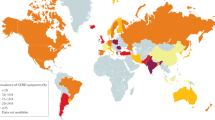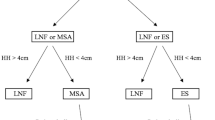Abstract
Management of patients with gastroparesis is challenging. Although the syndrome has multiple causes and knowledge of the pathophysiology and natural history is far from complete, a number of common management principles can be applied. The relatively poor correlation between upper-gastrointestinal symptoms and disordered gastric emptying represents a major difficulty in the therapeutic approach, and evidence to support the efficacy of current management strategies is often suboptimal, especially in relation to long-term therapy. In this review, the common causes and pathophysiology of gastroparesis are summarized, the diagnostic approach considered, and the evidence to support medical and surgical therapies reviewed. These therapies include currently available prokinetic drugs, novel medical therapies, and the promising technique of gastric electrical stimulation.
This is a preview of subscription content, access via your institution
Access options
Subscribe to this journal
Receive 12 print issues and online access
$209.00 per year
only $17.42 per issue
Buy this article
- Purchase on Springer Link
- Instant access to full article PDF
Prices may be subject to local taxes which are calculated during checkout

Similar content being viewed by others
References
Jones MP and Maganti K (2003) A systematic review of surgical therapy for gastroparesis. Am J Gastroenterol 98: 2122–2129
Soykan I et al. (1998) Demography, clinical characteristics, psychological and abuse profiles, treatment, and long-term follow-up of patients with gastroparesis. Dig Dis Sci 43: 2398–2404
Talley NJ (2003) Diabetic gastropathy and prokinetics. Am J Gastroenterol 98: 264–271
Tack J and Lee KJ (2005) Pathophysiology and treatment of functional dyspepsia. J Clin Gastroenterol 39 (Suppl): S211–S216
Jones KL et al. (2001) Predictors of delayed gastric emptying in diabetes. Diabetes Care 24: 1264–1269
Horowitz M et al. (1991) Relationships between oesophageal transit and solid and liquid gastric emptying in diabetes mellitus. Eur J Nucl Med 18: 229–234
Parkman HP et al. (2004) American Gastroenterological Association technical review on the diagnosis and treatment of gastroparesis. Gastroenterology 127: 1592–1622
O'Donovan D et al. (2003) Idiopathic and Diabetic Gastroparesis. Curr Treat Options Gastroenterol 6: 299–309
Ritz MA et al. (2000) Impacts and patterns of disturbed gastrointestinal function in critically ill patients. Am J Gastroenterol 95: 3044–3052
Horowitz M et al. (1994) Role and integration of mechanisms controlling gastric emptying. Dig Dis Sci 39 (Suppl): 7S–13S
Horowitz M et al. (2002) Gastric emptying in diabetes: clinical significance and treatment. Diabet Med 19: 177–194
Mearin F et al. (1986) Pyloric dysfunction in diabetics with recurrent nausea and vomiting. Gastroenterology 90: 1919–1925
Fraser R et al. (1993) Organization of antral, pyloric and duodenal motility in patients with gastroparesis. J Gastrointest Mot 5: 167–175
Rayner CK et al. (2001) Relationships of upper gastrointestinal motor and sensory function with glycemic control. Diabetes Care 24: 371–381
Lee KJ et al. (2004) Pathophysiology of functional dyspepsia. Best Pract Res Clin Gastroenterol 18: 707–716
Tack J et al. (1998) Role of impaired gastric accommodation to a meal in functional dyspepsia. Gastroenterology 115: 1346–1352
Azpiroz F and Malagelada JR (1987) Gastric tone measured by an electronic barostat in health and postsurgical gastroparesis. Gastroenterology 92: 934–943
Malagelada JR et al. (1980) Gastric motor abnormalities in diabetic and postvagotomy gastroparesis: effect of metoclopramide and bethanechol. Gastroenterology 78: 286–293
Camilleri M et al. (1998) Measurement of gastrointestinal motility in the GI laboratory. Gastroenterology 115: 747–762
Wright RA et al. (1985) Diabetic gastroparesis: an abnormality of gastric emptying of solids. Am J Med Sci 289: 240–242
Tougas G et al. (2000) Standardization of a simplified scintigraphic methodology for the assessment of gastric emptying in a multicenter setting. Am J Gastroenterol 95: 78–86
De Schepper HU et al. (2004) Assessment of gastric accommodation: overview and evaluation of current methods. Neurogastroenterol Motil 16: 275–285
Parkman HP et al. (2003) Electrogastrography: a document prepared by the gastric section of the American Motility Society Clinical GI Motility Testing Task Force. Neurogastroenterol Motil 15: 89–102
Koch KL et al. (1989) Gastric emptying and gastric myoelectrical activity in patients with diabetic gastroparesis: effect of long-term domperidone treatment. Am J Gastroenterol 84: 1069–1075
Horowitz M et al. (2001) Gastroparesis: prevalence, clinical significance and treatment. Can J Gastroenterol 15: 805–813
Jones KL et al. (1999) Hyperglycemia attenuates the gastrokinetic effect of erythromycin and affects the perception of postprandial hunger in normal subjects. Diabetes Care 22: 339–344
DiBaise JK et al. (2001) Effects of low doses of erythromycin on the 13C Spirulina platensis gastric emptying breath test and electrogastrogram: a controlled study in healthy volunteers. Am J Gastroenterol 96: 2041–2050
Fraser R et al. (1993) Dual effects of cisapride on gastric emptying and antropyloroduodenal motility. Am J Physiol 264: G195–G201
Ishii M et al. (1997) Erythromycin derivative improves gastric emptying and insulin requirement in diabetic patients with gastroparesis. Diabetes Care 20: 1134–1137
Tatsuta M et al. (1992) Effect of treatment with cisapride alone or in combination with domperidone on gastric emptying and gastrointestinal symptoms in dyspeptic patients. Aliment Pharmacol Ther 6: 221–228
Janssens J et al. (1990) Improvement in gastric emptying in diabetic gastroparesis by erythromycin. N Engl J Med 322: 1028–1031
Arts J et al. (2005) Influence of erythromycin on gastric emptying and meal related symptoms in functional dyspepsia with delayed gastric emptying. Gut 54: 455–460
Dhir R and Richter JE (2004) Erythromycin in the short- and long-term control of dyspepsia symptoms in patients with gastroparesis. J Clin Gastroenterol 38: 237–242
Edelbroek MA et al. (1993) Effects of erythromycin on gastric emptying, alcohol absorption and small intestinal transit in normal subjects. J Nucl Med 34: 582–588
Talley NJ et al. (2001) Effects of a motilin receptor agonist (ABT-229) on upper gastrointestinal symptoms in type 1 diabetes mellitus: a randomised, double blind, placebo controlled trial. Gut 49: 395–401
Talley NJ et al. (2000) Failure of a motilin receptor agonist (ABT-229) to relieve the symptoms of functional dyspepsia in patients with and without delayed gastric emptying: a randomized double-blind placebo-controlled trial. Aliment Pharmacol Ther 14: 1653–1661
Russo A et al. (2004) Effect of the motilin agonist KC 11458 on gastric emptying in diabetic gastroparesis. Aliment Pharmacol Ther 20: 333–338
Abell TL et al. (1991) Long-term efficacy of oral cisapride in symptomatic upper gut dysmotility. Dig Dis Sci 36: 616–620
Veysey MJ et al. (2001) Effects of cisapride on gall bladder emptying, intestinal transit, and serum deoxycholate: a prospective, randomised, double blind, placebo controlled trial. Gut 49: 828–834
Tonini M et al. (1999) Review article: cardiac adverse effects of gastrointestinal prokinetics. Aliment Pharmacol Ther 13: 1585–1591
McHugh S et al. (1992) Cisapride vs metoclopramide. An acute study in diabetic gastroparesis. Dig Dis Sci 37: 997–1001
Loo FD et al. (1984) Gastric emptying in patients with diabetes mellitus. Gastroenterology 86: 485–494
Ganzini L et al. (1993) The prevalence of metoclopramide-induced tardive dyskinesia and acute extrapyramidal movement disorders. Arch Intern Med 153: 1469–1475
Shaffer D et al. (2004) Tardive dyskinesia risks and metoclopramide use before and after U.S. market withdrawal of cisapride. J Am Pharm Assoc (Wash DC) 44: 661–665
Soykan I et al. (1997) The effect of chronic oral domperidone therapy on gastrointestinal symptoms, gastric emptying, and quality of life in patients with gastroparesis. Am J Gastroenterol 92: 976–980
Farup CE et al. (1998) Effect of domperidone on the health-related quality of life of patients with symptoms of diabetic gastroparesis. Diabetes Care 21: 1699–1706
Melga P et al. (1997) Chronic administration of levosulpiride and glycemic control in IDDM patients with gastroparesis. Diabetes Care 20: 55–58
Murray CD et al. (2005) Ghrelin enhances gastric emptying in diabetic gastroparesis: a double-blind, placebo-controlled, cross-over study. Gut [10.1136/gut.2005.069088]
Rabine JC and Barnett JL (2001) Management of the patient with gastroparesis. J Clin Gastroenterol 32: 11–18
Thumshirn M et al. (1999) Modulation of gastric sensory and motor functions by nitrergic and alpha-2-adrenergic agents in humans. Gastroenterology 116: 573–585
Dishy V et al. (2004) The effect of sildenafil on gastric emptying in patients with end-stage renal failure and symptoms of gastroparesis. Clin Pharmacol Ther 76: 281–286
Jones KL et al. (2000) Effects of fedotozine on gastric emptying and upper gastrointestinal symptoms in diabetic gastroparesis. Aliment Pharmacol Ther 14: 937–943
Clouse RE (2003) Managing functional bowel disorders from the top down: lessons from a well-designed treatment trial. Gastroenterology 125: 249–253
Lacy BE et al. (2002) Botulinum toxin for the treatment of gastroparesis: a preliminary report. Am J Gastroenterol 97: 1548–1552
Miller LS et al. (2002) Treatment of idiopathic gastroparesis with injection of botulinum toxin into the pyloric sphincter muscle. Am J Gastroenterol 97: 1653–1660
McCallum RW et al. (1998) Gastric pacing improves emptying and symptoms in patients with gastroparesis. Gastroenterology 114: 456–461
Lin Z et al. (2004) Treatment of diabetic gastroparesis by high-frequency gastric electrical stimulation. Diabetes Care 27: 1071–1076
Abell T et al. (2003) Gastric electrical stimulation for medically refractory gastroparesis. Gastroenterology 125: 421–428
Abell T et al. (2003) Gastric electrical stimulation for gastroparesis improves nutritional parameters at short, intermediate, and long-term follow-up. JPEN J Parenter Enteral Nutr 27: 277–281
McCallum R et al. (2005) Clinical response to gastric electrical stimulation in patients with postsurgical gastroparesis. Clin Gastroenterol Hepatol 3: 49–54
Cutts TF et al. (2005) Is gastric electrical stimulation superior to standard pharmacologic therapy in improving GI symptoms, healthcare resources, and long-term health care benefits? Neurogastroenterol Motil 17: 35–43
Ayinala S et al. (2005) Temporary gastric electrical stimulation with orally or PEG-placed electrodes in patients with drug refractory gastroparesis. Gastrointest Endosc 61: 455–461
Mintchev MP et al. (2000) Microprocessor-controlled movement of solid gastric content using sequential neural electrical stimulation. Gastroenterology 118: 258–263
Kim CH and Nelson DK (1998) Venting percutaneous gastrostomy in the treatment of refractory idiopathic gastroparesis. Gastrointest Endosc 47: 67–70
Ejskjaer NT et al. (1999) Novel surgical treatment and gastric pathology in diabetic gastroparesis. Diabet Med 16: 488–495
Watkins PJ et al. (2003) Long-term outcome after gastrectomy for intractable diabetic gastroparesis. Diabet Med 20: 58–63
Yamashita S et al. (2000) Longer-term diabetic patients have a more frequent incidence of nosocomial infections after elective gastrectomy. Anesth Analg 91: 1176–1181
Eckhauser FE et al. (1998) Safety and long-term durability of completion gastrectomy in 81 patients with postsurgical gastroparesis syndrome. Am Surg 64 711–717
Forstner-Barthell AW et al. (1999) Near-total completion gastrectomy for severe postvagotomy gastric stasis: analysis of early and long-term results in 62 patients. J Gastrointest Surg 3: 15–23
Gaber AO et al. (1991) Changes in gastric emptying in recipients of successful combined pancreas-kidney transplants. Dig Dis 9: 437–443
Kong MF et al. (1999) Natural history of diabetic gastroparesis. Diabetes Care 22: 503–507
Jones KL et al. (2002) A longitudinal study of gastric emptying and upper gastrointestinal symptoms in patients with diabetes mellitus. Am J Med 113: 449–455
Author information
Authors and Affiliations
Corresponding author
Ethics declarations
Competing interests
The authors are currently conducting a study involving prokinetic therapy for Axcan Pharmaceuticals.
Rights and permissions
About this article
Cite this article
Rayner, C., Horowitz, M. New management approaches for gastroparesis. Nat Rev Gastroenterol Hepatol 2, 454–462 (2005). https://doi.org/10.1038/ncpgasthep0283
Received:
Accepted:
Issue Date:
DOI: https://doi.org/10.1038/ncpgasthep0283
This article is cited by
-
Gastric emptying and glycaemia in health and diabetes mellitus
Nature Reviews Endocrinology (2015)
-
An update on autonomic neuropathy affecting the gastrointestinal tract
Current Diabetes Reports (2006)



